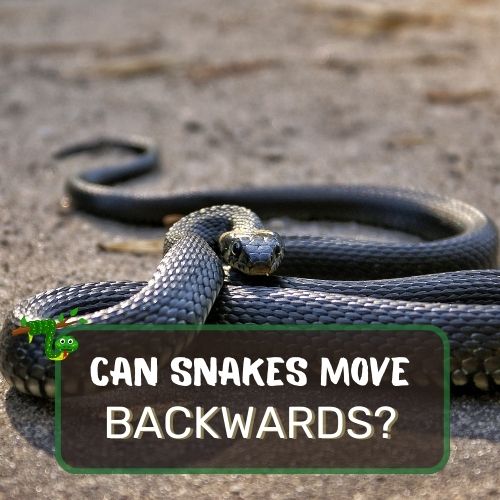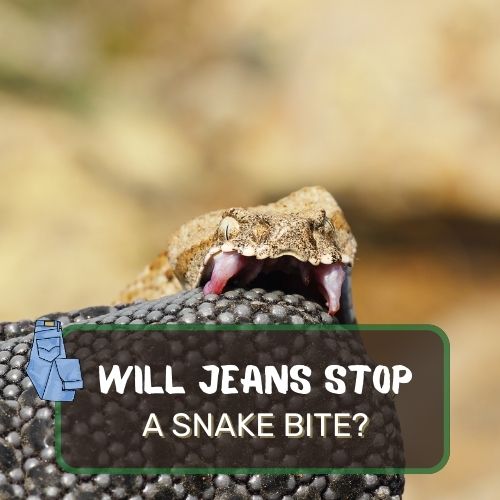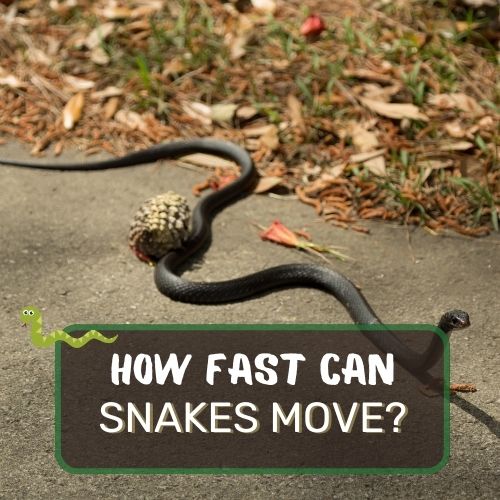
Welcome to a captivating journey into the world of serpents’ locomotion abilities, with a focus on the intriguing question: Can snakes move backward?
In this exploration, we unravel the mechanics behind this seemingly enigmatic skill, shedding light on the various techniques snakes employ for reverse movement, the factors influencing their choices, and the remarkable adaptations that facilitate this ability.
Embark on this expedition to gain a deeper understanding of these remarkable creatures, discovering the factors that influence their behavior, and unveiling the mysteries of their versatile movements.
Table of Contents
Can Snakes Move Backward? (Summary)
Yes, snakes can move backward. While their primary mode of movement is forward using a serpentine motion, snakes possess the ability to reverse their direction. They achieve this by using techniques such as turning their entire bodies or reversing the pattern of muscle contractions. However, moving backward can be energetically costly and less efficient compared to their natural forward motion. Snakes may use this skill to escape threats, navigate obstacles, or hide from predators. Their ability to move backward adds to the diverse array of locomotion strategies that make these creatures both fascinating and adaptable.
Snake Locomotion Basics

When it comes to the mesmerizing world of snakes, their movement patterns have always been a subject of fascination. These remarkable creatures exhibit a unique locomotion technique that is quite different from the way we, and many other animals, move.
Let’s dive into the intriguing realm of snake locomotion and explore how these slithery beings manage their backward maneuvers.
How Snakes Typically Move Forward
Picture a snake on the prowl, gliding through grass or across the ground with a fluidity that seems almost otherworldly. Snakes are renowned for their belly-crawling motion, using their scales and muscles to propel themselves forward.
This motion resembles a graceful wave as they undulate their bodies side to side, generating movement in the desired direction.
Serpentine Motion and Muscle Coordination
Serpentine motion, or lateral undulation, is the key to a snake’s forward movement. It involves a rhythmic, wave-like motion that moves sequentially down the body.
As the snake pushes against the ground with its scales, the waves of muscle contractions travel along the body, propelling the snake forward. This elegant dance between muscles, scales, and friction allows snakes to smoothly navigate their environment.
The Role of Scales in Snake Locomotion
The scales covering a snake’s body play a pivotal role in its locomotion. These scales aren’t just for protection; they contribute to the snake’s unique way of moving. Scales provide traction against the ground, preventing the snake from slipping and aiding in forward propulsion.
The directional orientation of the scales helps in reducing friction during forward movement, allowing the snake to glide with minimal effort.
Techniques Used by Snakes to Move Backwards

Moving backward is a different ball game altogether for snakes, and they’ve evolved various techniques to achieve this seemingly counterintuitive maneuver.
Turning the Whole Body to Go Backwards
Imagine a snake encountering an obstacle while moving forward. Instead of simply reversing its motion, snakes often employ a technique involving turning their entire bodies to change direction.
By angling its head to the side and curving its body, a snake can initiate a backward motion. This turning strategy allows them to navigate tight spaces or escape from tricky situations.
Crawling Backwards Using Muscle Contractions
Snakes also exhibit a mesmerizing ability to move backward by reversing the pattern of their muscle contractions. Just as with forward movement, they create waves of muscle contractions, but in the opposite direction.
These waves flow from tail to head, enabling the snake to glide smoothly in reverse. It’s like rewinding the undulating tapestry of their movement.
Factors Affecting Backward Movement
While snakes possess the remarkable capability to move backward, several factors influence their success in doing so. Energy consumption plays a significant role, as moving backward can demand more energy due to the need to overcome natural forward-oriented mechanics.
The direction of their scales also plays a role; if scales aren’t oriented optimally for backward motion, it could hinder their progress.
Snakes That Can Crawl Backwards

Not all snake species possess the ability to move backwards with finesse, but there are a few fascinating exceptions. Let’s explore the intriguing world of snakes that have mastered the art of reverse locomotion.
Overview of Backward-Crawling Snake Species
While many snake species are primarily adapted for forward movement, there are some that have developed the unique ability to crawl in reverse. These species often employ specific techniques and adaptations to achieve this feat.
Among them, sea snakes stand out as remarkable examples of snakes that have perfected the art of moving backward.
Sea Snakes: Masters of Reverse Movement
Sea snakes, a group of highly adapted aquatic reptiles, are known for their exceptional ability to move in reverse. These serpents not only glide gracefully through water but also exhibit precise control over their backward movement.
This remarkable talent is especially important for their survival in the marine environment.
Adaptations Enabling Sea Snakes’ Backward Movement
The sea snake’s backward-crawling ability is closely tied to its specialized adaptations. One key adaptation is the reduction of ventral scales, which lessens friction against the water.
Their laterally compressed bodies, combined with efficient muscular coordination, allow them to move with minimal resistance. This streamlined design, honed by evolution, empowers sea snakes to navigate with ease whether they’re going forward or backward.
Why Snakes Move Backwards

The question arises: why would a snake need to move backward when their usual forward motion seems so efficient? The answer lies in the myriad challenges and situations snakes encounter in their habitats.
Hiding from Predators
Snakes often need to move backward to escape potential predators. By retreating in reverse, they can maintain visual contact with the threat while still creating distance.
This strategic maneuver can buy them time to find cover or assess the situation before deciding whether to continue their retreat or change their course.
Escaping Danger or Threats
When confronted by danger or threats, snakes might employ their backward-crawling skills to quickly put distance between themselves and the source of peril. This instinctive response allows them to create a safety buffer and increase their chances of evading harm.
Snakes’ bodies are inherently flexible, enabling them to squeeze through tight openings and navigate challenging terrain. However, sometimes it’s easier to move backward through confined spaces, especially when their natural undulating motion isn’t feasible.
By reversing their movement, snakes can effectively navigate obstacles or negotiate narrow crevices in search of food or shelter.
In the intricate tapestry of nature, the ability of snakes to move backward serves as a testament to their adaptability and survival strategies.
From sea snakes gliding gracefully through aquatic realms to terrestrial serpents strategically retreating from threats, the art of backward motion showcases the incredible diversity of techniques these creatures have evolved to conquer their surroundings.
The Limitations of Snakes Moving Backwards

While snakes possess a remarkable ability to move backward, this reverse locomotion comes with its own set of challenges and limitations. Let’s delve into the intricacies of why moving backward might not always be the optimal choice for these enigmatic creatures.
Challenges and Energy Consumption
Moving backward requires a snake to counteract its natural mechanics optimized for forward movement. This can demand more energy and effort, as the snake’s muscular coordination and scale orientation are geared towards efficient forward propulsion.
Consequently, the energy expenditure during backward movement might be higher, making it a less favorable option unless necessary.
The Unpleasant Sensation of Scale Orientation
Snakes have specialized scales that aid in forward movement by minimizing friction. However, these scales aren’t always aligned optimally for backward motion.
When a snake moves backward, its scales might generate an uncomfortable sensation against the ground, leading to potential discomfort or abrasion.
This sensation could discourage snakes from relying on reverse locomotion extensively.
Comparing Forward and Backward Movement
In terms of efficiency and ease, forward movement is the natural choice for snakes. Their bodies are expertly designed for lateral undulation, making it their most energy-efficient mode of travel.
Forward movement enables them to maintain better balance, control, and overall momentum. While they can move backward, it’s important to note that snakes primarily rely on their forward-crawling prowess to thrive in their environments.
Interesting Facts about Snake Locomotion

Snake locomotion is a captivating field that offers a treasure trove of unique methods, adaptations, and characteristics that contribute to their diverse movement techniques.
Variety of Movement Styles in Different Snake Species
Beyond the well-known serpentine motion, snakes exhibit an array of movement styles. Sidewinding, observed in desert-dwelling species, involves a series of lateral movements to traverse sandy terrain efficiently.
Rectilinear movement, characterized by linear progression and minimal undulation, helps snakes navigate confined spaces with precision.
Adaptations Enhancing Locomotion Diversity
The diversity in snake locomotion is a testament to their adaptability. Snakes possess an array of adaptations that contribute to their versatile movement capabilities.
Whether it’s specialized scales for aquatic environments or the ability to alter their body shape for varying terrain, these adaptations highlight their incredible ability to thrive in diverse habitats.
As we unravel the mysteries of snake locomotion, we’re reminded that these creatures are the result of millions of years of evolution, each aspect of their movement finely tuned to their surroundings.
From backward gliding sea snakes to the specialized sidewinding of desert dwellers, the intricacies of snake locomotion paint a vivid picture of the fascinating world they inhabit.
FAQ
As we journey through the captivating world of snake locomotion, it’s natural to have questions. Let’s address some common queries to deepen our understanding of these mesmerizing creatures.
Can Corn Snakes Move Backwards?
Yes, like many snake species, corn snakes can indeed move backward. While their primary mode of movement is the same serpentine undulation seen in other snakes, they can employ the same techniques discussed earlier to move in reverse.
Do Snakes Crawl or Slither?
Snakes exhibit a fascinating blend of crawling and slithering. Their movement is often described as “slithering” due to the fluid motion created by their undulating bodies. However, they also employ crawling motions when navigating challenging terrain or obstacles.
Can Snakes Move in a Straight Line?
Snakes typically move in a curved or wavy path due to their lateral undulation. While they can move relatively straight, their characteristic undulating motion is a key feature of their locomotion.
Can Snakes Slither Up Walls?
Certain snake species, particularly those equipped with specialized scales and muscular adaptations, can indeed climb walls. Tree-dwelling snakes, for instance, use a combination of muscle strength and scale interactions to ascend vertical surfaces.
Conclusion
In the intricate world of snake locomotion, every curve and wave tells a story of survival, adaptation, and evolution. From their graceful serpentine movement to the exceptional skill of moving backward, snakes offer a stunning example of nature’s creativity.
Their ability to navigate diverse environments, escape threats, and explore their surroundings showcases the remarkable versatility of these creatures.
As we ponder the complexities of their movement, we gain a deeper appreciation for the marvels of the animal kingdom.
From the fluid grace of sea snakes gliding through the waves to the determined sidewinding of desert serpents, the art of snake locomotion is a captivating dance that speaks volumes about the wonders of life on Earth.
So, the next time you encounter a snake on its journey, remember the intricate mechanics that allow it to move with such elegance and purpose.




0 Comments